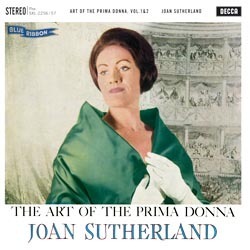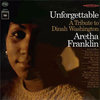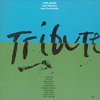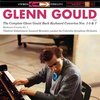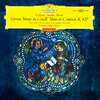Speakers Corner / Decca SXL 2256/57 - 180 Gram Virgin Vinyl -
Limited Edition - Pure Analogue Audiophile Mastering - Pressed at Pallas Germany
"The Art Of The Primadonna" - Joan Sutherland sings arias from operas by Thomas Arne, Vincenzo Bellini, Leo Delibes, Charles Gounod, Georg Friedrich Händel, Giacomo Meyerbeer, Wolfgang Amadeus Mozart, Gioachino Rossini, Giuseppe Verdi, a.o.
The 'art of the prima donna' stands out like a shining star in the firmament of virtuoso song repertoire and the world of grand opera. And this double LP pays homage to this cult. It is of little importance that the majority of the divas who are praised in the cover text celebrated their success long before the days of the phonograph and that therefore no recordings of them exist. After all, Joan Sutherland with her wonderfully supple and artistically flexible soprano voice is more than compensation, and she gives us an idea of how these works would have sounded in the salons of the 18th and 19th century.
Joan Sutherland is wonderfully British in her poised rendering of the opening work, Thomas Arne’s coloratura aria "The Soldier Tir’d", and in Handel’s jubilatory "Let The Bright Seraphim". But she earned her honorary title 'La Stupenda' by singing Italian repertoire. With utmost ease, agility and remarkable clarity in the top register, her voice gets right to the heart of bel canto. One of the most exquisite and beautiful roles is demonstrated in the demanding aria "Casta Diva" from Bellini’s "Norma", here sung in the original key. How lucky we are not to have to imagine how this great singer might have sounded, but can listen to her amazing voice over and over again.
"Ms. Sutherland’s singing was founded on astonishing technique. Her voice was evenly produced throughout an enormous range, from a low G to effortless flights above high C. She could spin lyrical phrases with elegant legato, subtle colorings and expressive nuances. Her sound was warm, vibrant and resonant, without any forcing." - Anthony Tommasini, The New York Times
July and August 1960 at the Kingsway Hall, London, with Kenneth Wilkinson
Production: Michael Bremner und Ray Minshull
Musicians:
Joan Sutherland
Royal Opera House Orchestra & Chorus
Francesco Molinari-Pradelli
Joan Sutherland The Art Of The Prima Donna Track Listing:
LP1
1. Arne – Artaxerxes: "The Soldier Tir'd"
2. Handel – Samson: "Let The Bright Seraphim"
3. Bellini – Norma: Recit. And Aria, "Casta Diva"
4. Bellini – I Puritani: Polonaise, "Son Vergin Vezzosa"
5. Rossini – Semiramide: "Bel Raggio"
6. Bellini – I Puritani: "Qui La Voce"
7. Bellini – La Sonnambula: Recit. And Aria, "come Per Me Sereno"
8. Gounod – Faust: "The Jewel Song"
LP2
1. Gounod – Romeo Et Juliette: "The Waltz Song"
2. Verdi – Otello: "The Willow Song"
3. Mozar – De Entfubrung Aus Dem Serail: "Marten Aller Arten"
4. Verdi – La Traviata: "Ah, Fors'e Lui" And "Sempre Libera"
5. Thomas – Hamlet: "The Mad Scene"
6. Delibes – Lakme: "The Bell Song"
7. Meyerbeer – Les Huguenots: "O Beau Pays"
8. Verdi – Rigoletto: Recit And Aria, "Caro Nome"Selections:
Recorded July and August 1960 in Kingsway Hall, London.
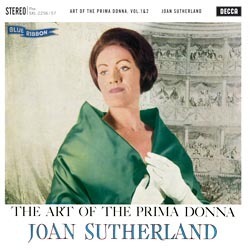
Are your records completely analogue?
Yes! This we guarantee!
As a matter of principle, only analogue masters are used, and the necessary cutting delay is also analogue. All our cutting engineers use only Neumann cutting consoles, and these too are analogue. The only exception is where a recording has been made – either partly or entirely – using digital technology, but we do not have such items in our catalogue at the present time
Are your records cut from the original masters?
In our re-releases it is our aim to faithfully reproduce the original intentions of the musicians and recording engineers which, however, could not be realised at the time due to technical limitations. Faithfulness to the original is our top priority, not the interpretation of the original: there is no such thing as a “Speakers Corner Sound”. Naturally, the best results are obtained when the original master is used. Therefore we always try to locate these and use them for cutting. Should this not be possible, – because the original tape is defective or has disappeared, for example – we do accept a first-generation copy. But this remains an absolute exception for us.
Who cuts the records?
In order to obtain the most faithful reproduction of the original, we have the lacquers cut on the spot, by engineers who, on the whole, have been dealing with such tapes for many years. Some are even cut by the very same engineer who cut the original lacquers of the first release. Over the years the following engineers have been and still are working for us: Tony Hawkins, Willem Makkee, Kevin Gray, Maarten de Boer, Scott Hull, and Ray Staff, to name but a few.
At the beginning of the ‘90s, in the early days of audiophile vinyl re-releases, the reissue policy was fairly straightforward. Companies such as DCC Compact Classics, Mobile Fidelity, Classic Records and others, including of course Speakers Corner, all maintained a mutual, unwritten code of ethics: we would manufacture records sourced only from analogue tapes.
Vinyl’s newfound popularity has led many other companies to jump on the bandwagon in the hope of securing a corner of the market. Very often they are not so ethical and use every imaginable source from which to master: CDs, LPs, digital files and even MP3s.
Even some who do use an analogue tape source employ a digital delay line, a misguided ’80s and ‘90s digital technology that replaces the analogue preview head originally used to “tell” the cutter head in advance what was about to happen musically, so it could adjust the groove “pitch” (the distance between the grooves) to make room for wide dynamic swings and large low frequency excursions. Over time analogue preview heads became more rare and thus expensive.
So while the low bit rate (less resolution than a 16 bit CD) digital delay line is less expensive and easier to use than an analogue “preview head”, its use, ironically, results in lacquers cut from the low bit rate digital signal instead of from the analogue source!
Speakers Corner wishes to make clear that it produces lacquers using only original master tapes and an entirely analogue cutting system. New metal stampers used to press records are produced from that lacquer. The only exceptions are when existing metal parts are superior to new ones that might be cut, which includes our release of “Elvis is Back”, which was cut by Stan Ricker or several titles from our Philips Classics series, where were cut in the 1990s using original master tapes by Willem Makkee at the Emil Berliner Studios. In those cases we used only the original “mother” to produce new stampers.
In addition, we admit to having one digital recording in our catalogue: Alan Parsons’ “Eye in the Sky”, which was recorded digitally but mixed to analogue tape that we used to cut lacquers.
In closing, we want to insure our loyal customers that, with but a few exceptions as noted, our releases are “AAA”— analogue tape, an all analogue cutting system, and newly cut lacquers.
